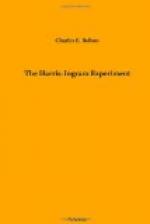Many monuments in St. Peter’s were erected to the memory of several of the famous Popes. The Vatican, the largest palace in Europe, is where the Popes came to reside after their return from Avignon, France, in 1377, for here they felt much security in the vicinity of the Castle S. Angelo, with which it communicated by a covered gallery. For a time the Popes vied with each other in enlarging and embellishing the Vatican, which covers an immense space, and is a collection of separate buildings; the length is 1150 feet, and the breath 767 feet. The Vatican is said to contain 20 courts, and 11,000 halls, chapels, salons, and private apartments, most of which are occupied by collections and show-rooms, while only a small part is set apart for the papal court.
The Harrises visited the most celebrated portions of the Vatican; the Scala Regia, covered with frescoes of events in Papal history, the Sistine Chapel, adorned with fine frescoes by Michael Angelo, including the Last Judgment. Here the Cardinals meet to elect the Pope, and here many of the most gorgeous ceremonies of the Roman Catholic Church are performed.
Equally enthusiastic were Leo and Lucille over Raphael’s superb frescoes in the Loggie, and in the chambers adjoining. The few pictures in the gallery are scarcely surpassed. The museum contains some of the noblest treasures of art, including the Laocoon, and Apollo Belvidere. The library is very valuable. The superb palace of the Quirinal has beautiful gardens.
Besides the several elegant public palaces in Rome, there are in and near the city over sixty private palaces or villas; the finest of which is the Barberini Palace. Several of the villas are located above terraces amid orange and citron groves, and they are ornamented with statues and fountains. Leo with pride took his friends to see the Colonna Palace, which contained many old portraits of his family.
After dinner a drive was taken outside the Porta del Popolo to the magnificent Villa Borghese and the Pincian Hill. It was planned to visit on the morrow the gallery Borghese, next to the Vatican, the most important in Rome. It was dark as Leo returned with his party to the hotel. The landlord handed him a gentleman’s card which read,
Mr. Ferdinand Francisco Colonna.
Piazza Colonna, Rome.
The landlord said that this gentleman was waiting for Leo in the reception-room. Leo at once recognized the card as that of his cousin, who was an attorney in Rome, and he hurried to meet his relative. They grasped hands warmly, and soon were in earnest conversation.
Ferdinand, taking a large official envelope from his pocket, opened it and began reading what he called a very important paper. It was a copy of the will of their rich uncle, who had just died, while inspecting his possession in Sicily. Leo Colonna bore the name of this uncle, his father’s oldest brother, who was fond of art, and who was never married. He had always been attached to Leo, his nephew, and in his will Leo was made his sole heir. Great was Leo’s surprise to learn that he was now not only the owner of a fine palace southeast of Rome, but of large possessions in Rome, Sicily, and South America.




